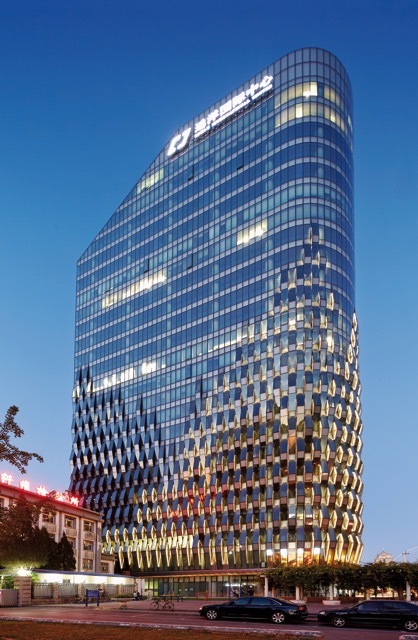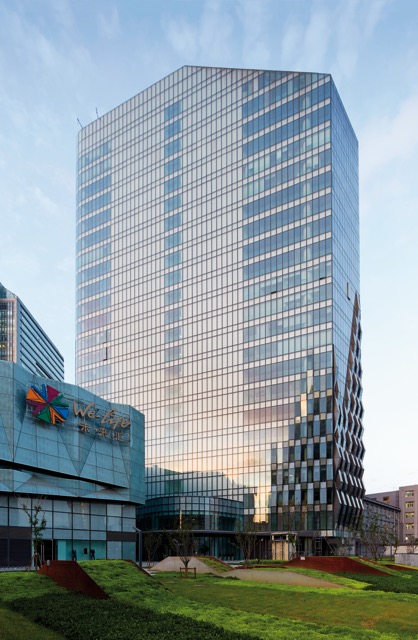
To the naked eye, the unique look of the Jing Mian Xin Cheng complex in Beijing, China, might not remind anyone of days gone by.
But on closer examination of the two office towers that sit atop a retail podium – and by detailed explanation from the principal at SPARK, which conceived the mixed-use design – it becomes obvious that efforts were made to pay homage to a textile market that once occupied the site.
The architect often uses the words ‘pleated’ and ‘woven’ to describe the towers’ textured façades. There are ‘pleats’ of perforated aluminium sheeting and a ‘weave’ of rippling windows that resolve a variety of practical issues while harkening back to earlier tenants.
“The pleating and weaving effects emerged from visualising the façades as pieces of three-dimensional fabric rather than paper-thin curtain walls,’ says SPARK Director Jan Felix Clostermann. “The façade engages with interior space by sculpting new habitable zones at the building’s edge.”
Clostermann says that the texture, which dissolves into a flat, glassy curtain wall with height, “baffles traffic noise from the ring road and offers a level of acoustic protection to the interior.

“The façade’s depth also creates new sites for natural ventilation and for an elaborate exterior lighting scheme that makes the textile-inspired texture stand out at night.”
The eye-catching mixed-use development adjacent to Beijing’s Fourth Ring Road was the winner of a ‘Best Office and Business Development’ accolade at the MIPIM Asia Awards 2013. The entire development consists of the two office towers and a retail podium immediately adjacent to the road, with a protected public plaza to their rear.
Given that the massing of the blocks was predicated and constrained by the sunlight requirements of a residential development to the north of the site, SPARK’s work focused on the detailed design of the façade and landscape.
Clostermann says the ‘thickened’ facades perform a number of functions beyond enclosure. First, besides muffling traffic noise, they provide a level of acoustic protection to the interior. The weave effect on the towers is thus concentrated at the lower levels, fading out with height. Secondly, in the case of the woven glazing, the façade engages with interior space by sculpting new habitable zones at the building’s edge.

Simultaneously, the woven glazing establishes new opportunities for ventilation.
“The weave allowed us to add small side openings for natural ventilation,” Clostermann says. “In most of Beijing’s Grade A office developments, windows are very large, heavy, top-hung panels that are difficult to operate and prone to falling.
“Many building operators do not allow windows to be opened for this reason, yet air conditioning is usually switched off at 6 p.m. and remains off on weekends. This is a problem for those who need to work beyond regular office hours.”
Smaller, lighter, and much easier to use, Jin Mian Xin Cheng’s side windows are thus a practical and low-tech solution to a common problem. The extremities of the ‘weave’ serve an additional function as easily accessed light boxes for night-time illumination of the building.

In a similar vein, SPARK’s landscape design for the plaza establishes a habitable topography of folds on the horizontal plane.
“The ground folds up to create seating, and to demarcate different zones in the plaza for different activities,” says Clostermann. “This continuation of the theme in the landscape design assures a pedestrian experience as impactful as the visual experience of the passing motorist. “
SPARK, international architects with offices in London, Singapore, Beijing, and Shanghai, hope their latest mixed-use design, located near Beijing’s Fourth Ring Road, will serve as a reminder that ‘depth of experience need not be forgotten despite the speed of the city’s expansion.’ SPARK’s award-winning studios create distinctive buildings for their clients and great places for people. Their designs emerge from a detailed analysis of context, brief, and typology, using innovation to drive social, environmental and economic value. SPARK delivered projects in Asia, Europe, the Middle East, Africa, India, and Australia. Each one has its own unique spark and manifests SPARK’s desire to tackle and deliver on challenges that reflect the key global imperative of attaining a sustainable, life-improving environment for all.
Web / sparkarchitects.com